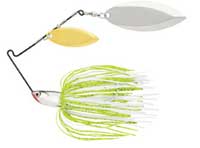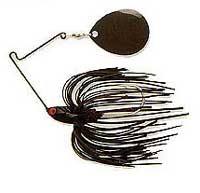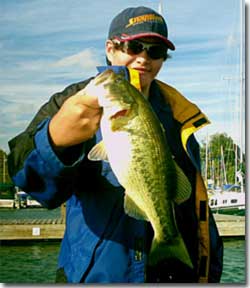Spinnerbaits: Ultimate Bass Catchers
Spinnerbaits: Ultimate Bass Catchers
By Richard Sims
There are few lures that anglers use that they can have confidence using in almost any conditions or waterways. One of these lures is the spinnerbait. Over the years it has evolved into perhaps the most versatile bass catcher there is out there. When spinnerbaits started out, they were basically long wired, single colorado (round) bladed baits that were meant for muddy water. These days, there are so many variations that they can be used just about anywhere, anytime. By varying the blades a little, you can adjust from crystal clear water to pea soup in seconds and still pull hefty bass out. Well now I'm going to teach you everything I know about these versatile bass catching machines. The Different Styles  As you probably know, there are several different styles of spinnerbaits on today's tackle market. The first style I will talk about is the long wired version. This is best suited for heavy vegetation as the longer wire helps it glide through weeds much better. Most spinnerbaits are short wired on the market. Short wired spinnerbaits are your basic, all-purpose types and can be used for just about anything! The wire itself can be made of aluminum, steel, titanium or even tungsten. Personally, I prefer titanium spinnerbaits as they never require tuning. I have tested many different types of titanium baits and Terminator's line just comes out on top. All-around they are the best detailed, durable and innovative spinnerbaits that I have seen. As you probably know, there are several different styles of spinnerbaits on today's tackle market. The first style I will talk about is the long wired version. This is best suited for heavy vegetation as the longer wire helps it glide through weeds much better. Most spinnerbaits are short wired on the market. Short wired spinnerbaits are your basic, all-purpose types and can be used for just about anything! The wire itself can be made of aluminum, steel, titanium or even tungsten. Personally, I prefer titanium spinnerbaits as they never require tuning. I have tested many different types of titanium baits and Terminator's line just comes out on top. All-around they are the best detailed, durable and innovative spinnerbaits that I have seen. The wire is not the only thing to think about when selecting spinnerbaits. Blades are also an incredibly important part of spinnerbaiting... debatably the MOST important part. Willow blades, Colorado blades, Indiana blades and recently Oklahoma and Wide Willow blades are just some of the blade choices there are for spinnerbaits. Each has a specific purpose. Willow blades are long, slender and are shaped like a willow leaf. They give off the maximum amount of flash, but offer less vibration. Colorado blades are wide and circular, and give off lots of vibration, yet, to compromise, have less flash than the willow blade. Indiana blades are a cross between willow and colorado and have almost an egg shaped appearance to them. Obviously they give off an even mix of flash/vibration. Terminator's innovation has been the Oklahoma blade. This is, in my opinion, a better cross between willow/colrado blades because of it's unique shape. I have had a LOT of success with the Oklahoma blade this past year. Other companies offer "wide willow" or other variations that are basically attempts at the Oklahoma blade, but none compare. Blade colors are basically gold and silver. I'll get into when to use each later on in this article.  Other important components of the spinnerbait are the head and the hook. The head weight will define how fast the lure sinks, and perhaps what depth it runs at. It will also change how you cast. As with any lure, it is important to have a strong, sticky sharp hook on your bait. Another part of spinnerbaits is trailers, or trailer hooks. You can use anything as a trailer on a spinnerbait, as it basically just gives the bait a bit more bulk and allows it to stay more bouyant. Trailer hooks are used when fish are short-striking the bait and you need that extra little bit to hook and land them. Other important components of the spinnerbait are the head and the hook. The head weight will define how fast the lure sinks, and perhaps what depth it runs at. It will also change how you cast. As with any lure, it is important to have a strong, sticky sharp hook on your bait. Another part of spinnerbaits is trailers, or trailer hooks. You can use anything as a trailer on a spinnerbait, as it basically just gives the bait a bit more bulk and allows it to stay more bouyant. Trailer hooks are used when fish are short-striking the bait and you need that extra little bit to hook and land them. When & Where To Use Spinnerbaits Seasonally I have very little experience with winter fishing as in my area the lakes ice-over during that time. But I can basically cover where to throw spinnerbaits during all of the other seasons. Spring Since bass are moving into shallow areas to spawn and looking for warm water, you spinnerbaits as a search bait. Some people say that spinnerbaits are the best pattern in the springtime. For the most part, you'll want to slow-roll spinnerbaits at this time. This means letting the bait sink to the bottom, and then reeling it in just fast enough to turn the blades. Use it around spawning coves and on drop-offs in the area. All spawning areas will have deep water access nearby, so try slow rolling it in the deeper water as well. A good technique for suspended fish (as they tend to do at post-spawn) is to find the general depth the bass are holding at with the depth finder. After doing this and making a rough estimation, cast your bait out and let it sink all the way to the bottom, counting the seconds it takes to get there in your head. Then you can use the amount of seconds as mental depth markers and reel the bait in at the general depth where you want it to be. Summer In the summertime, bass are usually in two places: 1) Deep structure areas, 2) shallow, heavy cover. Smallmouth for the most part will be in deep areas, as will largemouth. Spinnerbaits are great baits to use at deep structure areas. Use the "countdown" technique mentioned above to keep the bait at the bass' level during those hot days. Sometimes in the early morning, afternoon or on overcast/rainy days you can reel the bait in near the surface and pick up some active bass. This is especially true for smallmouth, but largemouth will do the same. When spinnerbaiting shallow areas, remember that bass aren't going to move far to hit your bait. Be as quiet as possible with casts and try to be accurate at the same time. Flipping and pitching spinnerbaits can do well during the summer. A favourite technique of mine is a stop & go retrieve with tandem spinnerbaits alongside docks in the summer for big largemouth. Fall In my opinion, this is the best time of year to use a spinnerbait. Bass are feeding on shad and other baitfish heavily, so if a lure that resembles one goes past their face, they will more than likely take a heavy swipe at it. The best part is how hard they fight at this time of year! This is another good time for slow rolling. Remember that you have to work areas really thoroughly in the fall. If your bait is a foot or more away from the bass' face, he may not even look at it. Being stealthy is of less importance since fish are usually schooled near the bottom and are ready to eat anything that is near them. I prefer white spinnerbaits with silver blades for the most part at this time of year, since they resemble shad very well. Techniques The techniques associated with spinnerbaiting vary. I'll try to cover as many as I can for you. Ripping This is as simple as ever. Basically for this technique you will want a bait with either a single willow or a double willow blade arrangement, and a short wire. What you do is cast the bait out to your desired area (usually as far as you can cast it), and then reel it in as fast as possible while still keeping the spinnerbait running properly. I guess this is a good time to mention that if your spinnerbait is running upright, it's running improperly. If it's a titanium wire, you are reeling too fast or too slow. If it's a different material wire, you will need to tune it. Just bend the wire in the direction that the spinnerbait is leaning to. Eventually it will run properly. To avoid this problem, use titanium spinnerbaits. Slow Rolling This is the exact opposite of ripping. Reel the bait in as slowly as possible, while still keeping the blades turning and the bait running upright. If the blades are having trouble turning at the start, give it a little jerk, then begin your slow retrieve. Single colorado bladed baits are good for slow rolling near the surface. Stop & Go This is as simple as the name states. While reeling in the bait at your desired speed, use jerking motions with your rod, then pick up slack after jerking. Do not reel while jerking the rod. It will make your bait "stutter" during the retrieve and will make for good reaction strikes. I have found this especially deadly on pike, and on bigger bass. It gives the appearance of a dyeing baitfish, which can often trigger strikes from bass that would not hit a normal straight retrieve spinnerbait. If you have a trailer on the spinnerbait, it will add even more action because the trailer and skirt will thrive and pulsate around, adding a more "live" feel to the bait. Equipment  This can vary depending on the size of bait that you're throwing. Generally, for baits heavier than 1/2 ounce, I like a medium-heavy action 6'6" baitcasting rod coupled with a medium action baitcasting reel, spooled with 14-20lb test monofilament. For baits lighter than that, a 6' medium or medium-light baitcasting rod coupled with a medium-light action baitcasting reel and 10-14lb test monofilament does the trick nicely. For micro spinnerbaits (i.e. Terminator Tiny-T's), a 4 & a half to 5' ultra light rod teamed with an ultra light reel and 4-6lb mono does the trick nicely. This is a good setup for panfish and smaller bass, but never underestimate it's effects on larger bass! This can vary depending on the size of bait that you're throwing. Generally, for baits heavier than 1/2 ounce, I like a medium-heavy action 6'6" baitcasting rod coupled with a medium action baitcasting reel, spooled with 14-20lb test monofilament. For baits lighter than that, a 6' medium or medium-light baitcasting rod coupled with a medium-light action baitcasting reel and 10-14lb test monofilament does the trick nicely. For micro spinnerbaits (i.e. Terminator Tiny-T's), a 4 & a half to 5' ultra light rod teamed with an ultra light reel and 4-6lb mono does the trick nicely. This is a good setup for panfish and smaller bass, but never underestimate it's effects on larger bass! Overall As you can see, spinnerbaits are possibly the most versatile, effective bass catching lures there are on the market. With all the different styles, combinations and colors you can really be set all year round with a bass catching bait. Never underestimate these baits as they have won tournaments from coast to coast in the United States and Canada. If you haven't used spinnerbaits yet.. do so! I have certainly benefitted from these baits several times this year and I'm sure you will too. Enjoy yourselves out there, stay safe and catch a trophy! Tight Lines!
To purchase any of the Strike King Titanium Elite Spinnerbaits...
Strike King Titanium Elite Colorado Willow Spinnerbait
Strike King Titanium Elite Double Willow Spinnerbait
Strike King Titanium Elite Double Colorado Spinnerbait
|
